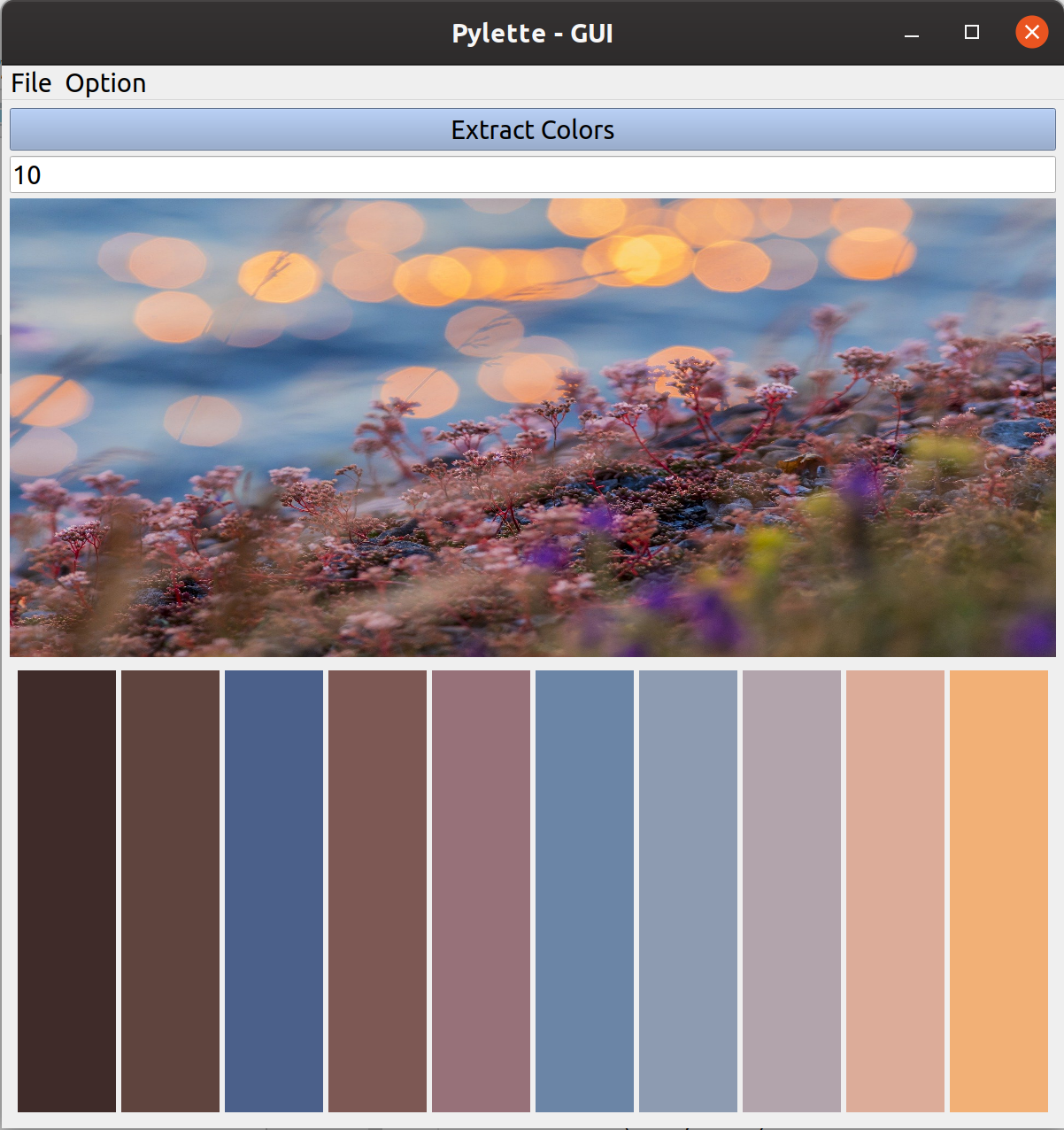A color palette extractor written in Python using KMeans clustering.
Working with computer graphics and visualizations, one often needs a way of specifying a set of colors with a certain visual appeal. Such a set of colors is often called a color palette. The aim of this library is to easily extract a set of colors from a supplied image, with support for the various color modes (RGB, RGBa, HSV, etc). Dabbling in generative art, the need often arises for being able to pick colors at random from a palette. Pylette supports this, both picking colors uniformly, but also using the color frequency from the original image as probabilities.
- Color Thief: Extraction of color palettes using the median cut algorithm.
- Palettable: Generation of matplotlib compatible color schemes
- Colorgram: Extraction of colors from images (similar to the intended use of this library), however, I was unable to install this.
Pylette is available in the python package index (PyPi), and can be installed using pip:
pip install PyletteA Palette object is created by calling the extract_colors function.
from Pylette import extract_colors
palette = extract_colors('image.jpg', palette_size=10, resize=True)
palette = extract_colors('image.jpg', palette_size=10, resize=True, mode='MC', sort_mode='luminance')This yields a palette of ten colors, and the resize flag tells Pylette to resize the image to a more manageable size before
beginning color extraction. This significantly speeds up the extraction, but reduces the faithfulness of the color palette.
One can choose between color quantization using K-Means (default) or Median-Cut algorithms, by setting in the mode-parameter. One can also specify to alternatively sort the color palette by the luminance (percieved brightness).
The palette object supports indexing and iteration, and the colors are sorted from highest to lowest frequency by default. E.g, the following snippet will fetch the most common, and least common color in the picture if the palette was sorted by frequency, or the darkest to lightest color if sorted by luminance:
most_common_color = palette[0]
least_common_color = palette[-1]
three_most_common_colors = palette[:3]As seen, slicing is also supported.
The Palette object contains a list of Color objects, which contains a representation of the color in various color modes, with RGB being the default. Accessing the color attributes is easy:
color = palette[0]
print(color.rgb)
print(color.hls)
print(color.hsv)To display the extracted color palette, simply call the display-method, which optionally takes a flag for saving the palette to an image file.
The palette can be dumped to a CSV-file as well, where each row represents the RGB values and the corresponding color frequency (optional).
palette.display(save_to_file=False)
palette.to_csv(filename='color_palette.csv', frequency=True)In order to pick colors from the palette at random, Pylette offers the random_color-method, which supports both drawing
uniformly, and from the original color distribution, given by the frequencies of the extracted colors:
random_color = palette.random_color(N=1, mode='uniform')
random_colors = palette.random_color(N=100, mode='frequency')A selection of example palettes. Each palette is sorted by luminance (percieved brightness). The top row corresponds to extraction using K-Means, and the bottom row corresponds to Median-Cut extraction.
| Original Image | Extracted Palette |
|---|---|
 |
  |
 |
  |
 |
  |
The new version of Pylette also comes bundled with a command line tool, which can be used to extract color palettes from the command line.
usage: pylette [-h] [--mode {KM,MC}] [--n N] [--sort_by {luminance,frequency}]
[--stdout STDOUT] [--colorspace {rgb,hsv,hls}]
[--out_filename OUT_FILENAME] [--display-colors DISPLAY_COLORS]
filename
positional arguments:
filename path to image file
optional arguments:
-h, --help show this help message and exit
--mode {KM,MC} extraction_mode (KMeans/MedianCut (default: KM)
--n N the number of colors to extract (default: 5)
--sort_by {luminance,frequency}
sort by luminance or frequency (default: luminance)
--stdout STDOUT whether to display the extracted color values in the
stdout (default: True)
--colorspace {rgb,hsv,hls}
color space to represent colors in (default: RGB)
--out_filename OUT_FILENAME
where to save the csv file (default: None)
--display-colors DISPLAY_COLORS
Open a window displaying the extracted palette
(default: False)Pylette now comes bundled with a barebones graphical user interface, using PyQt5 as the backend. From the command line, the GUI can be accessed by running
pylette_guiopens the interface. Import an image by clicking
File -> Open Imageselect the number of colors, and hit "Extract Colors". Hover over each extracted color to see the corresponding RGB values.
In future versions, automatic copy of hex-values to clipboard, and additional options for the extraction will be available in the GUI menus.
Currently, Pylette uses KMeans for the color quantization. There are plans for implementing other color quantization schemes, like:
- Median-cut [Implemented]
- Octree
- Modified minmax
The article Improving the Performance of K-Means for Color Quantization gives a nice overview of available methods.
Any feedback and suggestions is much appreciated. This is very much a work in progress.
